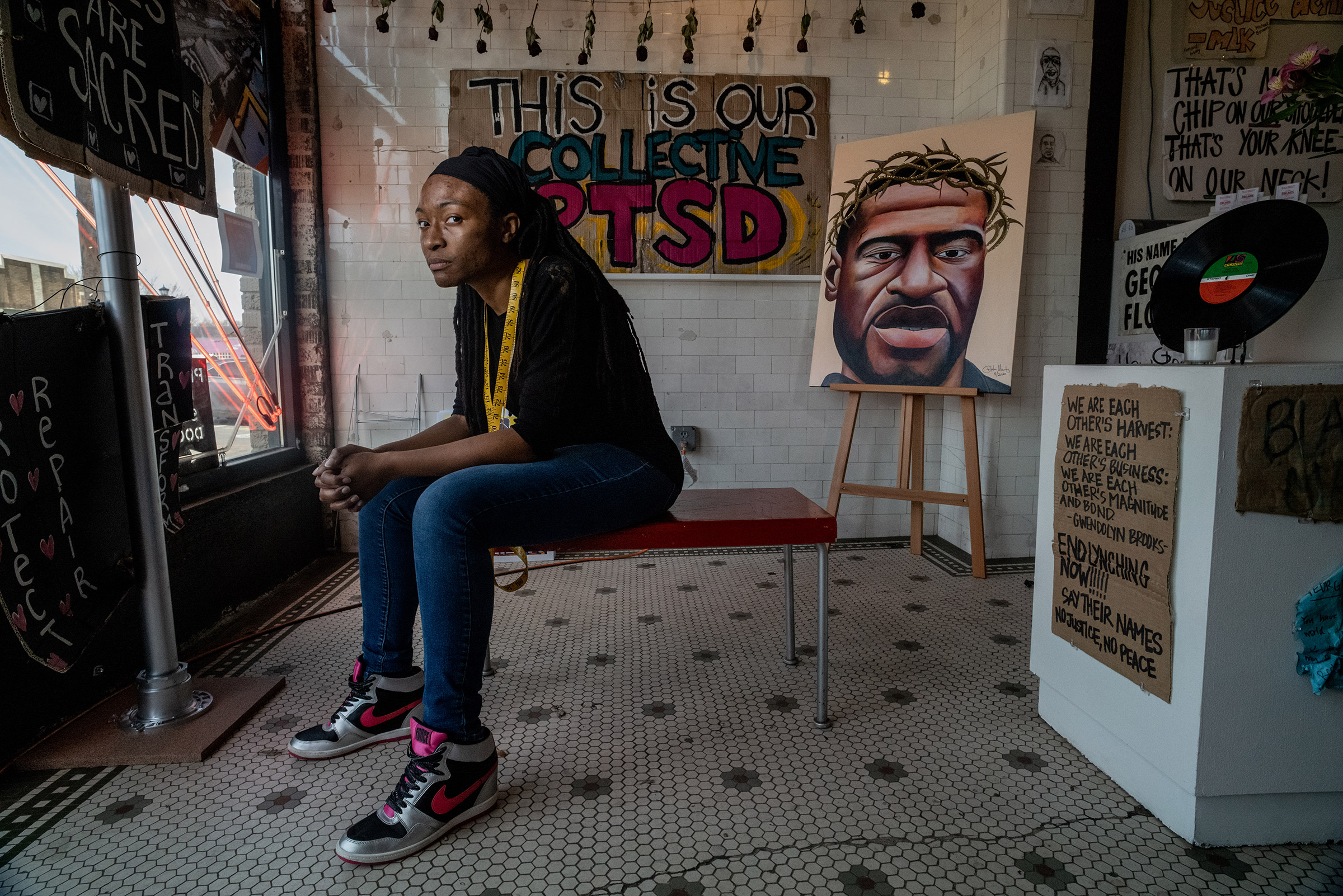Like a lot of us, Alfonzo “Box” Williams, 44, saw the footage—the last moments of George Floyd’s life, at 38th Street and Chicago Avenue—online, the day after Floyd died.
A giant teddy bear of a man, Box was shaken. To him, the way Floyd died seemed ice cold, just insane. Box made a call to the man he describes as his “big cousin,” the diminutive and charismatic Reggie Ferguson. Another call went to Marquise Bowie, a cousin of another cousin. The three men decided they should go to the intersection. They should get involved in what would happen next.
The three men are part of a Mississippi family that migrated to Minnesota during a mid-20th century boom in both racial violence and economic opportunity, forces that would send millions of Black Americans scrambling out of the South, only to find that the North had its own problems. In Minneapolis, all three cousins have done much they aren’t proud of, but all three, now middle-aged, can currently boast about their roles in the community—Box as a business owner and married dad, Ferguson as an entrepreneur and volunteer, Bowie a retail worker, mentor and father. And having seen what they’d seen in the city’s South Side neighborhoods, they felt obligated to act when Floyd died.
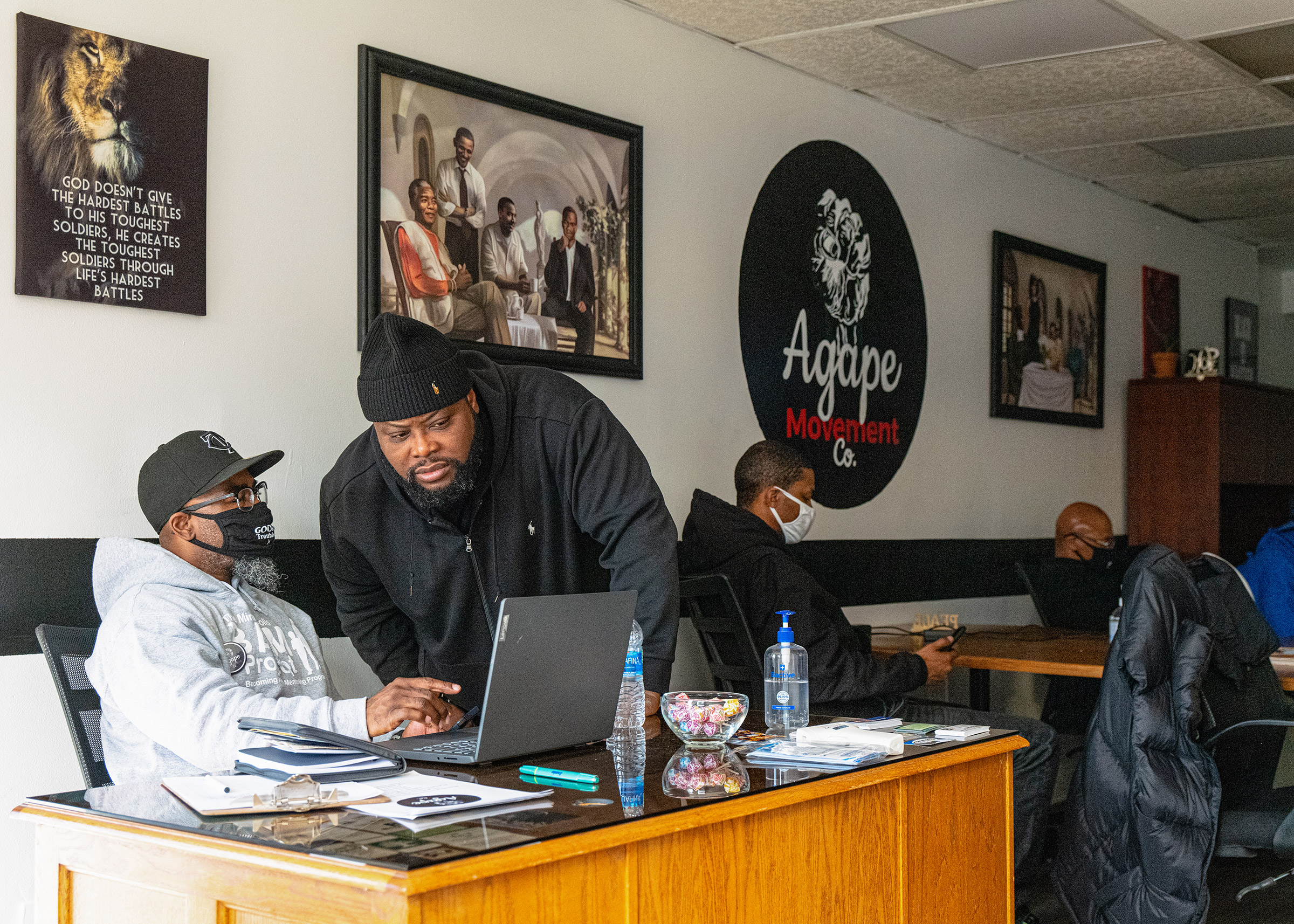
“Don’t get me wrong,” Box, tells me shortly after the start of former police officer Derek Chauvin’s ongoing murder trial in connection with Floyd’s death. “There’s been a lot more stuff besides George Floyd around here that we should have come out and stood for. We just didn’t.”
This time, they did.
By the time Box, his cousins and a few other men arrived at 38th and Chicago, there was already talk among the activists there about shutting down the intersection. Within days, activists attached to all sorts of causes and concerns had barricaded the immediate half a block to two block area in every direction from the spot where Floyd died. The resulting space was now a strange kind of sacred ground, smack dab in the middle of long-standing Bloods territory. George Floyd Square was born.
Almost a year later, the shutdown continues. For 10 months, police have, according to multiple accounts, scarcely entered the area. It has been barricaded by activists with entry, for the most part, limited to private citizens on foot.
Read more: ‘America Is on Trial’ as Derek Chauvin Faces Justice in the Death of George Floyd

To many observers, the blockaded area shows what the country might become if police no longer have the legal and social authority to operate as they see fit. But there’s something else here to behold. The death of a Black man, little known in life, under a white police officer’s knee, has stirred professed insight and a sense of grief, anger and obligation from all kinds of people, across the nation and the world. People here are no different. Here in George Floyd Square, Floyd’s death, and the way people like Box and his cousins have tried to honor it, can’t be parsed simply with crime statistics and the easy taxonomy of good and bad neighborhoods, police control and lawlessness. George Floyd Square does not present the ready-made excuse for unchecked policing some think it does, though it might be a place to watch the real-world impact of violence-prevention measures like the ones President Joe Biden called for on April 8.
City officials have announced plans to reopen the square after the Chauvin trial ends, over the objections of some in the area. What is left behind will likely mean different things to different people—but if the people who created the square have anything to say about it, it will not, like so much of the map of Black death in America, simply disappear.
A place set apart
While American history is dotted with places like George Floyd Square—People’s Park in Berkeley, Calif., in 1969, to name one—the idea of the autonomous zone really took off in anarchist circles about 30 years ago, says Todd Gitlin, a sociologist who teaches at Columbia University School of Journalism, who studies political and social movements. His 2012 book Occupy Nation: The Roots, the Spirit, and the Promise of Occupy Wall Street, examined the temporary autonomous zone at Zuccotti Park in New York City in 2011.
“The term autonomous zone is meant, I think, to invoke a mood,” says Gitlin, “which is, you know, basically a secessionist mood. We are sick and tired of your stodgy and/or oppressive society. We are seceding.”
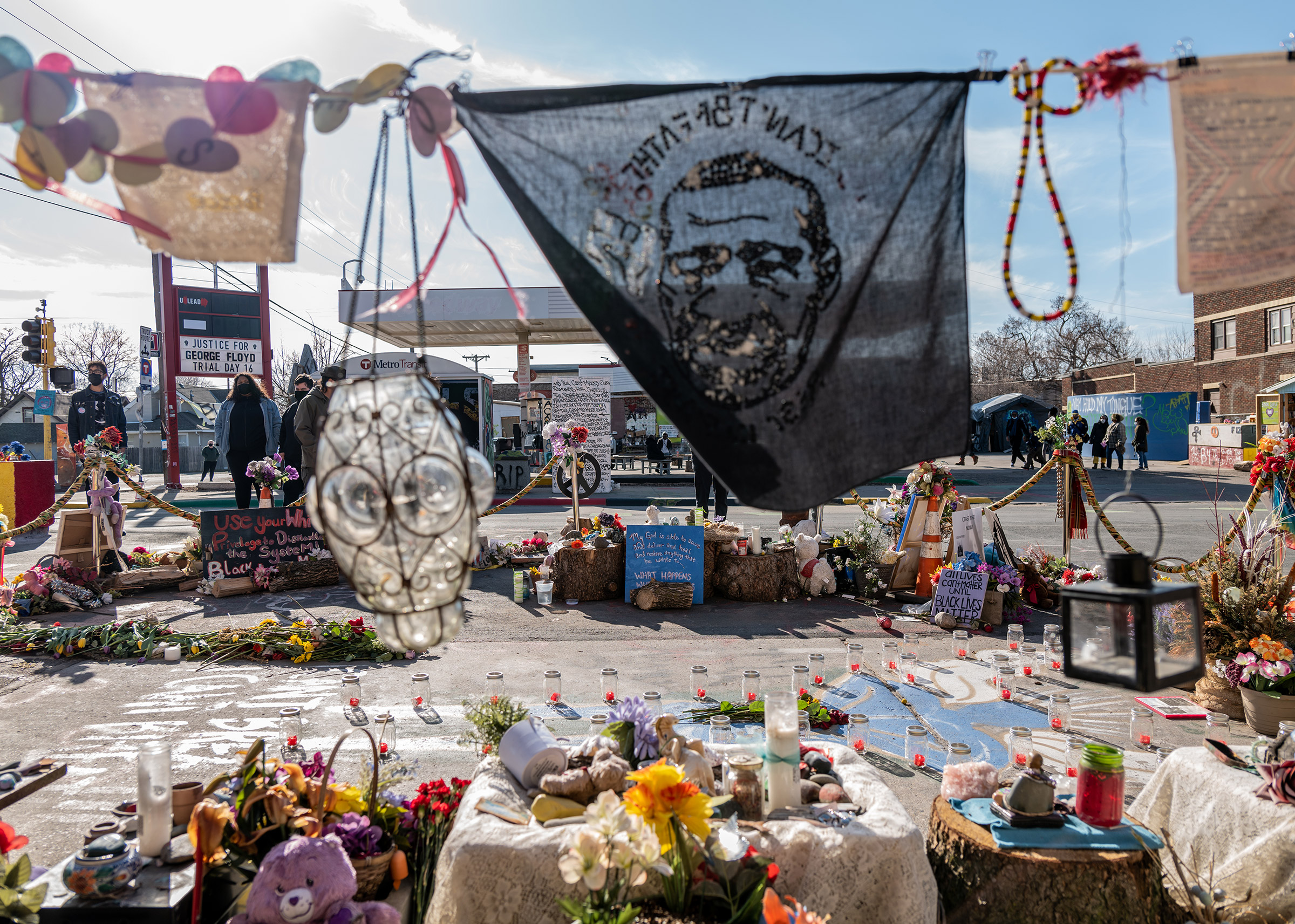
The influential 1991 book The Temporary Autonomous Zone, by the controversial author Hakim Bey, advanced the idea that spaces where alternative ways of organizing the world or a community can be tried out, without official interference, can produce meaningful things. But both Bey and Gitlin say that autonomous zones have a tendency to fall apart. After about a year to a year and a half, they either dissolve or devolve into something authoritarian, Bey has said. Many are consumed by disagreements over banal things like chores, though some have managed to have impacts that last beyond their expiration dates—Zuccotti Park, for example, produced a growing national consciousness about income inequality.
In a few weeks, the so-called autonomous zone near George Floyd Square will reach its first anniversary.
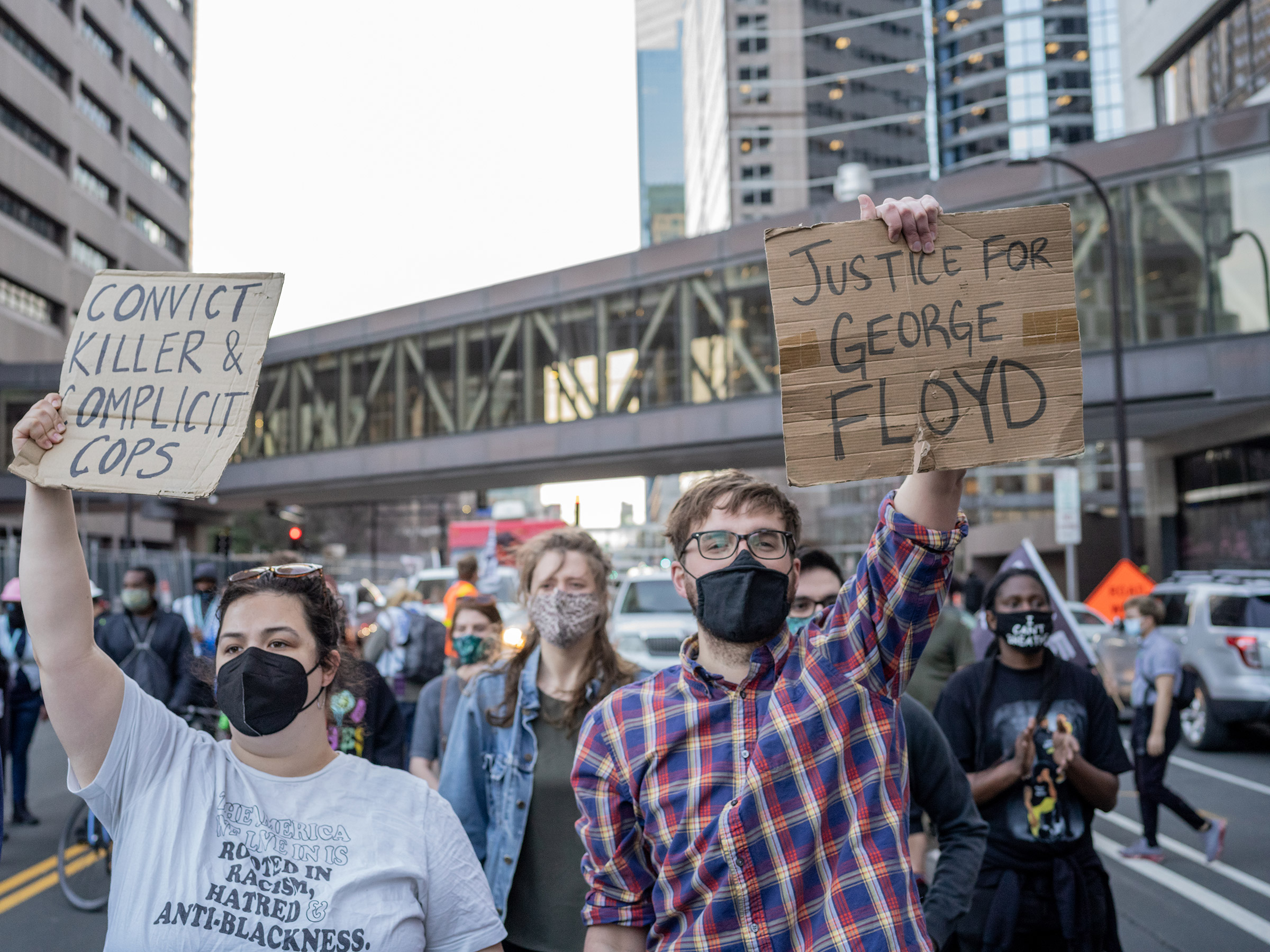
Read more: It’s a ‘Nightmare Being Replayed’ as a Cop Faces Trial in George Floyd’s Death
To Box and his compatriots, the square’s sanctity is worth protecting—from official intervention, as well as from vendors of what one activist told me were “George Floyd t-shirts, George Floyd socks, even George Floyd drawers”—not only because it is the place where Floyd died, but also because it’s where the people took a stand. It’s now a place where people in what folks in Minneapolis call Over South know they can come to find free food, clothing, books and shoes if they need them, as well as job-search help, gang-member exit services and meaningful space to acknowledge a modern form of racialized violence.
Others, however, are rooting for its dissolution. The mayor does not acknowledge the zone’s existence and no city agency would confirm to TIME that police do not enter, though during the week I spent in the square in June 2020, just after Floyd’s death, uniformed officers and marked police cruisers never appeared in the barricaded areas. When I returned this month, the same was true. Since June 2020, there have been at least four murders inside or just beyond the square, each replete with tragic details. At the same time, police presence in the city overall has changed—in Minneapolis, officers began quitting and taking extended time off at far higher rates this year, Minneapolis police data shows—just as violent crime rose, as it did in many American cities. The rate of violent crime in the area is statistically comparable to at least one other neighborhood in the city, but officials have complained that the barricades and anti-police environment make emergency response difficult. (Activists say police themselves delayed help.) This, critics say, is what happens when you disempower the police, remove them from dominion over any and everything in a geographic area.

To some degree, both views of George Floyd Square are true.
On a Tuesday in early April, a photojournalist and I working together in the square were threatened by a white man who identified himself as a Blood. He ordered us, loudly, to stop working. When a volunteer in the square rushed over to intervene, the man pulled a gun. We were fortunate to all walk away unharmed, the cousins later told us. But on Friday of the same week, in the square, I see a couple walk through still dressed in their wedding clothes. They have just come from the courthouse, where Chauvin’s trial is underway. They want to document their day in what signs declare “The Free State of George Floyd.”
“The reality is that where George Floyd was killed has always been Bloods territory,” says Sasha Cotton, director of Minneapolis’ two-year-old Office of Violence Prevention, an agency that saw its funding nearly tripled by city officials to about $7.4 million in the 2021 budget. That’s up from $2.5 million last year and still only a fraction of the Minneapolis Police Department’s $164 million allocation.
Cotton hails from what she describes as an underserved St. Paul neighborhood called Rondo that has a lot of kinship with the area near 38th Street and Chicago Avenue. She’s among those leery of the limited-to-absent police presence in and around George Floyd Square. But she’s also among those willing to look to 38th Street and Chicago Avenue for answers.
“[It’s] where violence happens,” Cotton says, “but also where great, beautiful things about community and culture happen.”
Something that will last
In the spot where Floyd died—where the trinkets of almost every faith’s mourning’s traditions and an outline of Floyd’s body in blue paint can be spotted—the outdoor memorial still stands. There are stones and rosaries, candles and photos, flags, ribbons, lanterns, bells and beads, and flowers, so many flowers, on the ground, in vases and plastic wrapping. A woman who lives a few blocks from the square named Jeanelle Austin, known around here as the caretaker or the curator, is working with the board of what is now known as the George Floyd Global Memorial to catalogue every item left behind, with the goal of creating a long-term installation or museum staffed by area residents.
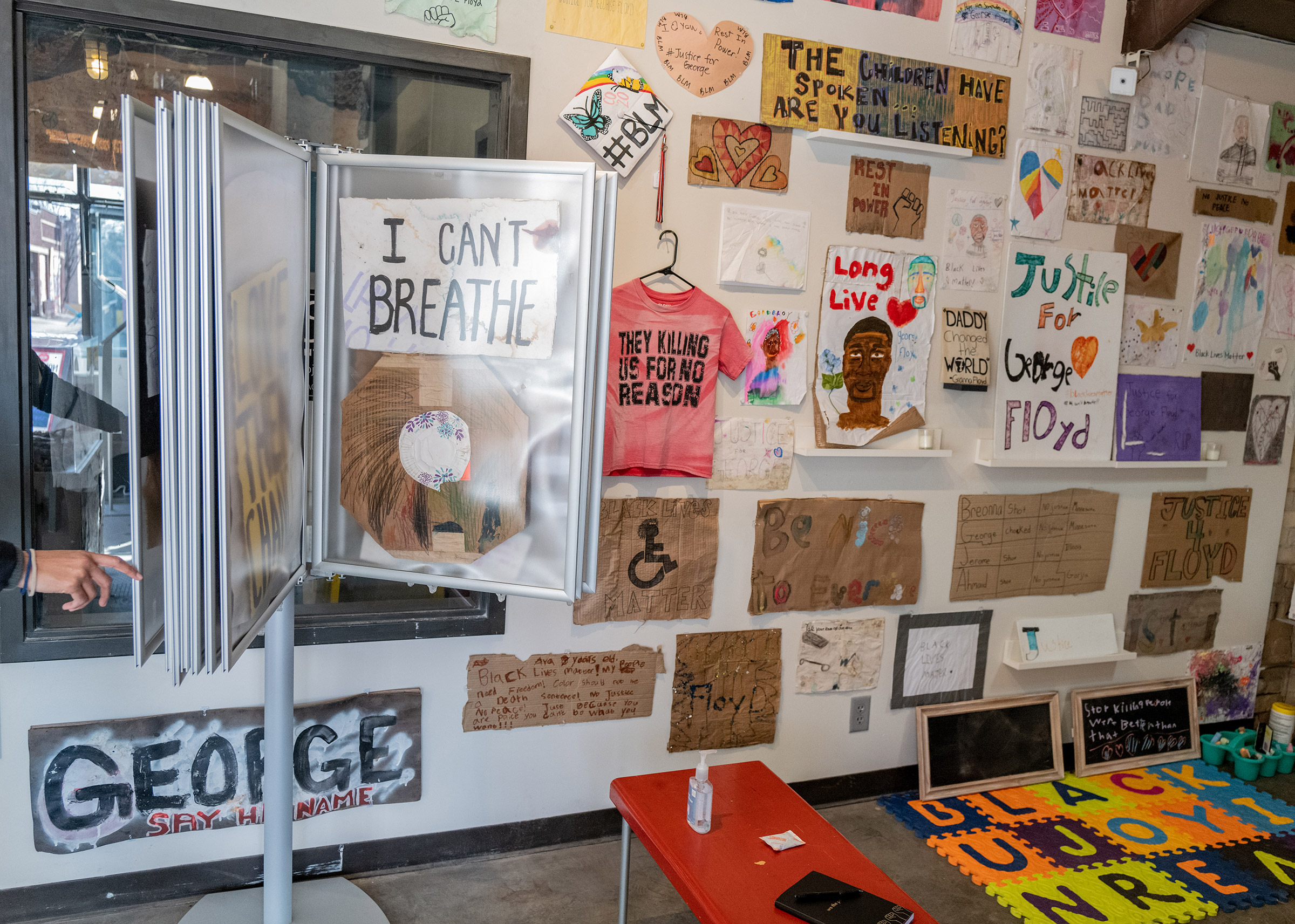
When Austin, who spent most of her career working for Christian educational institutions, speaks, bits of philosophy and even poetry slip out. Austin is raising three biracial boys a few blocks from the square. She cries when she tells me that her youngest son, the one with the darkest skin, asked his brothers if they would come be with him if he were lying dead in the street. So, like the cousins, she’s intently focused on the practical, on creating something lasting and life changing for others out of what happened to Floyd.
If she and others in the square have their way, that lasting something will be more than the physical remains of the memorial.
Read more: America’s Policing System Is Broken. It’s Time to Radically Rethink Public Safety

On a recent evening , just across the intersection at what, before Floyd’s death, used to be a functioning Speedway gas station and store, some people are beginning to take seats on what look like rough-hewn church pews. It’s almost time for what used to be a nightly meeting, a time to discuss goals and plans in George Floyd Square. By August, the assembly here—made up of multiple groups advancing various projects and initiatives—developed a list of 24 demands, available to square visitors on laminated cards, that they say must be met before the square reopens.
Demand 1: recall Mike Freeman, the area’s District Attorney, a man elected in a county-wide race, whom activists believe has been slow to prosecute police officers.
Demand 10: Create a $400,000 area job creation fund to reduce violence.
Up Chicago Avenue sits a pristine bungalow with a new “for sale” sign. In 2019, the median Black income in Hennepin County—$38,358—wasn’t enough to afford or in many cases qualify for a mortgage on most South Minneapolis homes; this one will likely go to one of the many white people moving into the neighborhood, a friend of Box’s named Derek “Debo” Armstrong tells me. Nearby, a two-story house with a wide front porch is where, in the early 2000s, an 11-year-old girl was shot and killed while doing her homework.
Activist demands 14 and 15: a moratorium on property tax increases in the area, and creation of a a rent-to-own option on new construction. Demand 4: open an investigation into the case of the Black man who insists he was wrongfully convicted in the girl’s killing. In December, a state pardon board commuted his sentence to 20 years with his remaining time to be served under supervised release; he was released from prison in December at the age of 34.
Austin and the other caretakers’ work can be seen inside the Chicago Avenue Fire Arts Center, inside the square. For now, the operators have shared their front room, where Austin and others maintain a “rememory space.” Entering generates sensations familiar from the raw days after Floyd died, proof that something here will endure. But with the square’s forced reopening on the horizon, just one of the demands has been even partially met.
Love in action
Reggie Ferguson isn’t sure that all of the activists’ demands are realistic, but he and his cousins do have plans. What they’ve dubbed the Agape Movement is just one of several initiatives—sometimes working in harmony, sometimes clashing—that have sprung up in the square, using it as a home base from which to demand and foster change.
Agape is the Greek word for brotherly or sacrificial love. Their group has grown from the cousins’ attempt to help as needed into a standing effort to change what it is like to live in the area. The Agape Movement has become a nonprofit with offices inside the square, in a two-story gray stucco house just a few hundred feet down Chicago Avenue from where Floyd died; getting them a home base is the activist demand (Number 18) that the city helped to meet. There, they work to help people who want out of gang life, calming conflicts and connecting area residents with employers willing to hire people who may have criminal records. And in just 10 months, this group of men, men our country is often inclined to dismiss as lost causes, have created a vessel for potential change—change the city is now willing to invest in.
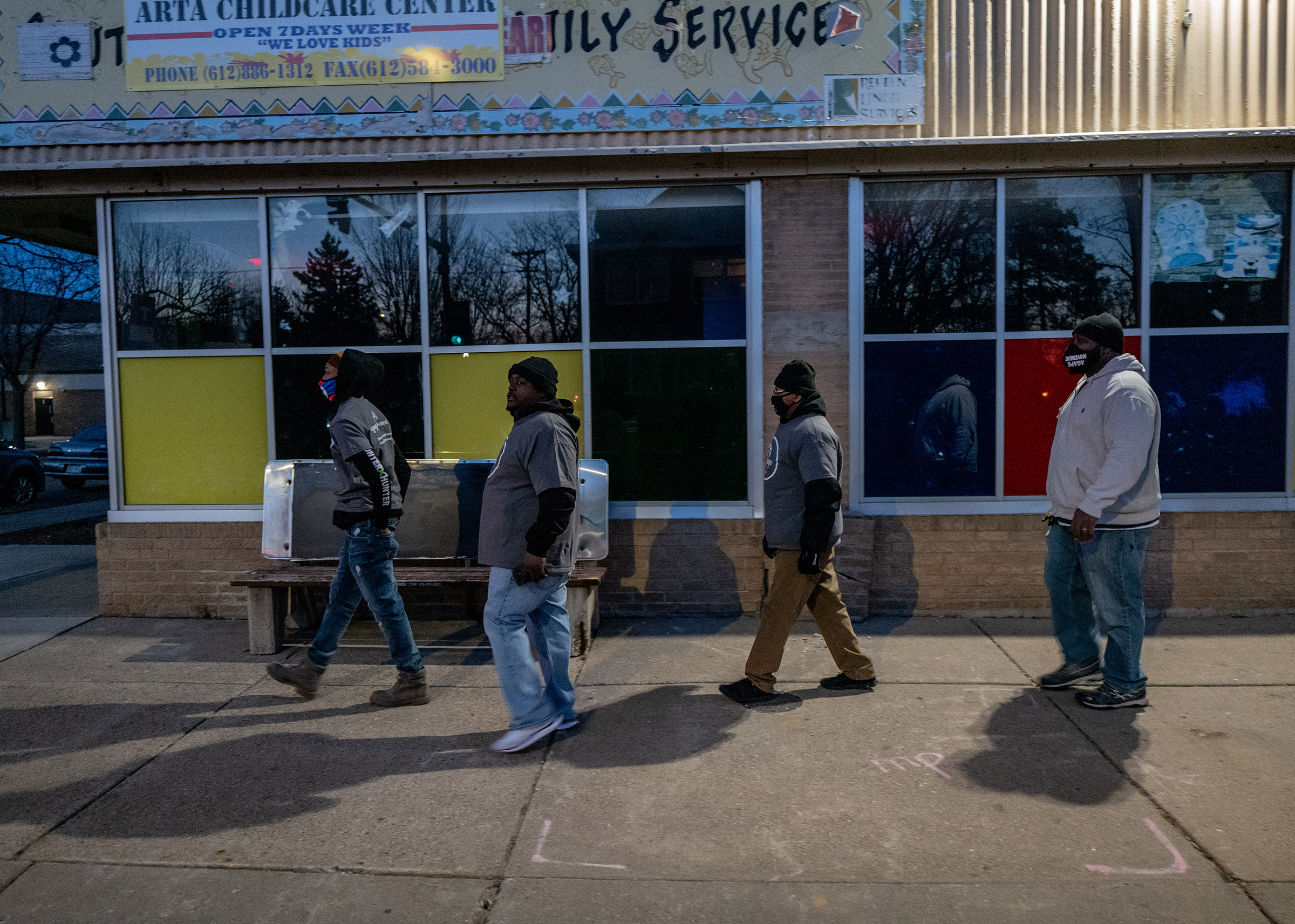
The men of Agape tend to gather on Wednesdays. On one recent such afternoon, men began to filter into the group’s meeting room around 3:00 p.m. There were some warm greetings, some good-natured ridicule about who has a date-night outfit on, and some talk about what was happening with their jobs and children. The men coming through Agape’s door were Black. Many have criminal records. They’ve spent sometimes more than a decade in prison. Quite a few were born to, have or had gang ties. They are the people America has long considered the problem. But they live in the area. They are willing to engage in the work of changing what they do not like—and changing themselves. They have to be people who merit and give respect. And, as the saying goes, it’s hurt people who hurt people. They can’t be those men, anymore.
“It was just trauma, trauma, trauma,” Bowie says, explaining that his life veered off course at 16, after his best friend was killed. “Out of my 15 boy cousins, 12 or 13 of us have been in prison for long stints of time. At some point, we got to fix that.”
Read more: George Floyd’s Death and the Long History of Racism in Minneapolis
On that day, the work meant a nearly two-hour Zoom meeting preview of something that may be critical to Agape’s future: formal violence-interrupter training.
Trying to stop people from doing what they once did can be dangerous; Box was shot in the foot last July when he tried to intervene in what became the fatal shooting of a pregnant woman. But when asked about the danger, Bowie answers quickly, without flinching.
“We put our lives on the line all the time for nothing, before,” he says.
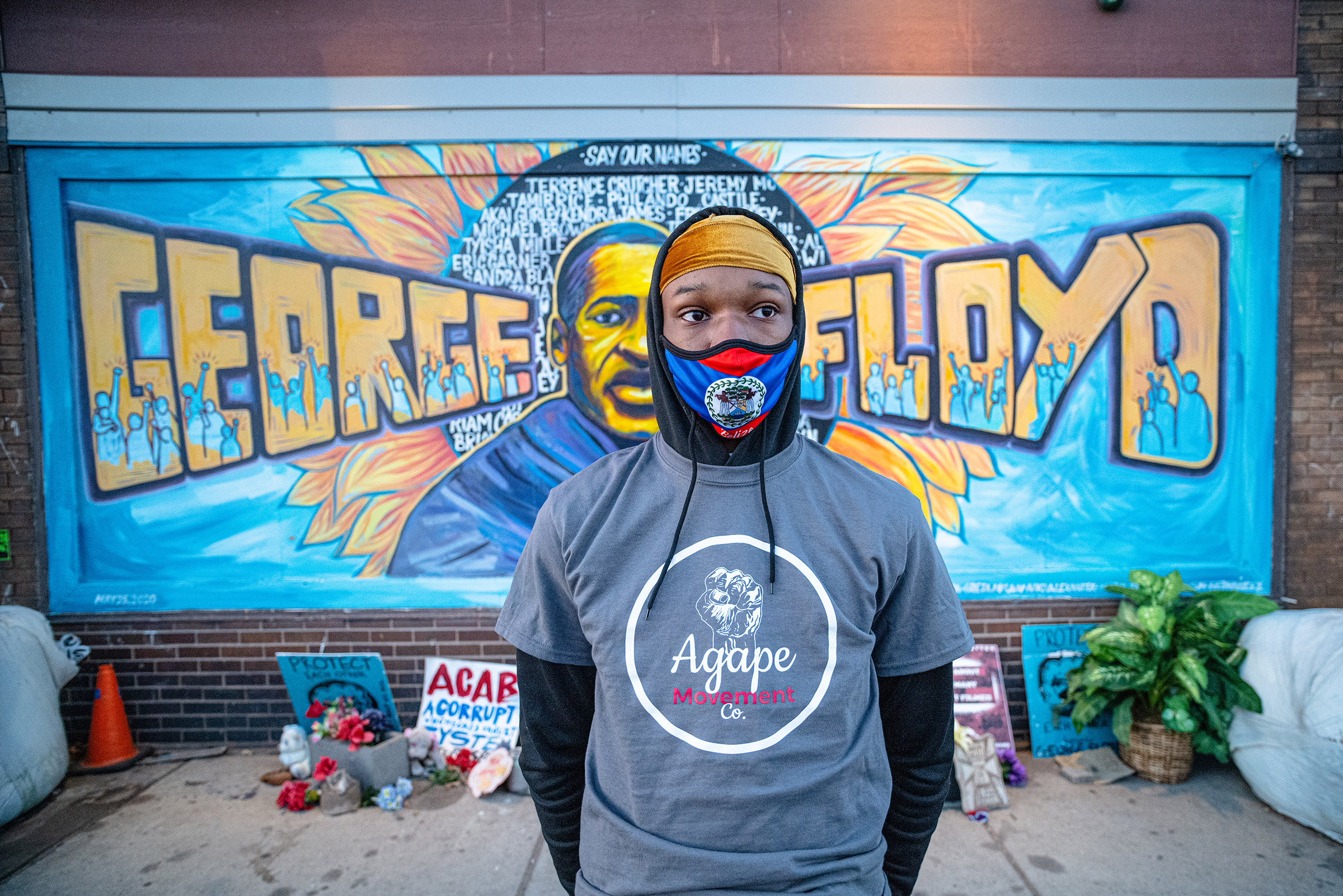
There is plenty of room to question or critique Agape. They don’t allow women to join, for example. But they are, at the very least, there. They put themselves in danger in the name of styming crime—the very thing that critics claim can’t happen if the police don’t have more of a presence in the square. They will show up for those in trouble at 2:00 a.m. and know about feuds 25 years ago between the two warring party’s uncles. In most cases, Agape men have “done the heavy lift of changing their own lives,” the Office of Violence Prevention’s Cotton says.
There are people in Minneapolis who doubt the wisdom of relying on people with criminal records and street connections. But the city is in crisis, so Cotton says it is prepared to take some chances. That includes the Agape men.
Last week, the city council approved a plan that will bring formal violence-interrupter training, along with other resources to expand the organization’s reach, to the Agape Movement and a partner organization called Cando. The Agape men will be paid to do the work they have already begun.
“That being said, capacity is not built in a day,” Cotton says, about the group but also the Office of Violence Prevention, created a little over two years ago. “We have had our police department in this city for 154 years and they still haven’t perfected keeping people safe. So the notion that we, as an office that was developed about two years ago, are expected to have figured it all out? I think, [the] city, but certainly our office, around the issue of public safety, is like a very awkward teenager.”
In the interim, the Agape men have continued the routines they developed since George Floyd died. One of them is a Thursday night patrol, four blocks in any direction from the square. On a Thursday in early April, out on Chicago Avenue, the lights are on at a shop called Pie & Mighty. Three white women are standing in the doorway. Ferguson introduces himself. Someone hands the business owner a flyer with information about the Agape movement and contact information. Anytime, day or night, call, Ferguson explains. Agape is here to help.
Box is smiling again.
“This to me is my thing, what it’s all about,” Box explains as we move up Chicago Avenue. “This is love in action.”

With reporting by Leslie Dickstein
More Must-Reads from TIME
- How Donald Trump Won
- The Best Inventions of 2024
- Why Sleep Is the Key to Living Longer
- Robert Zemeckis Just Wants to Move You
- How to Break 8 Toxic Communication Habits
- Nicola Coughlan Bet on Herself—And Won
- Why Vinegar Is So Good for You
- Meet TIME's Newest Class of Next Generation Leaders
Contact us at letters@time.com
